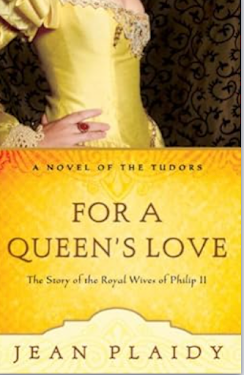Publication Date: January 1, 1954
Length: 338 pages
The original title of this book is The Spanish Bridegroom and as Plaidy's books have been republished, some are being renamed. Her popularity has grown in the last two decades as people have rediscovered these classics. I have been wanting to read this book for a long time as it concerns a person I know almost nothing about. Thanks to the author I have learned some very interesting facts about Phillip of Spain. I am honestly surprised this was renamed the way it was because the queens take a backseat to Phillip in this tale. The original title was much more applicable to the content. His story is absolutely fascinating too.
The book is divided into three sections: Maria of Manoela, Mary Tudor, and Elisabeth De Valois. I was curious as to why Plaidy didn't include Phillip's last wife, Anna of Austria with whom he spent the most years with. I would have liked for the story to have continued to the end of Phillip's life but I guess she decided three case studies were all she wanted to focus on.
The story begins with Phillip's childhood and his living in the shadow of his powerful father, Charles V, the Holy Roman Emperor. Being a more serious, religiously bent person, Phillip struggles to connect with people in a warm way, and finds it hard to tolerate fun and frivolity. He is influenced at a young age by romantic notions of love when his cousin, Maria of Portugal is sent to him as a young bride and his infatuation of her causes him to lose his carefully guarded feelings. Maria, young and naive as well, is adrift in a strange land and although appreciates her new husband's attentions, finds Phillip to be hesitant about showing too much affection. Maria gives birth to their son, Don Carlos, who proves to be a disaster from start to finish. Without giving too much of the main story away, Carlos factors into the book throughout all the way to the end and his life is as wild and interesting as any of the other people mentioned. He could have had his own tale all by himself.
After the death of Maria, Phillip marries Mary Tudor of England with the hope of solidifying relations between Spain and England, thwarting France, and strengthening the hold of Catholicism in Europe. Mary is quite a bit older than Phillip and along with still mourning the young, beautiful Maria, Phillip is repulsed by both Mary's looks and desperate, clinging behavior. He spends much of the time doing his duty of trying to beget a spare heir to hopefully replace his unstable son Carlos while finding a way to quickly get away from Mary and his miserable life with her in England. When Mary passes after many failed attempts at producing a child, Phillip is relieved and finds himself free from a drab life, ready to find another queen to marry.
When Phillip marries his third queen, Elisabeth De Valois he is a seasoned King, older and less naive in his views of the world and of women but nevertheless is enchanted by his French bride. She is only 14 when they wed in contrast to Phillip's 32 years but her beauty and kindness resonate with the entire household and as she was originally promised to Phillip's son, Carlos, her subsequent betrothal to the King causes great tension between Father and Son that never fully resolves itself. Once again, Phillip hopes this younger wife will produce a son, an heir to replace his first one. Elisabeth, daughter of Henry II and the infamous Catherine de Medici, finds herself at first fearful of her Mother's disapproval, even though she is far away in France but as she becomes more comfortable in her role as Queen of Spain, begins to mature and rely more on Phillip's growing attachment and the positive confidence he instills in her. Just when she starts to imagine a contented life with her husband, Elisabeth learns how cold he can be as she watches in horror the ruthlessness of the Spanish Inquisition and Phillip's radical nature emerges. He turns into a frightening figure who is a religious zealot, showing no mercy to the poor people, imprisoned, tortured, and killed for their beliefs.
This was a dark book, especially for Plaidy. She says in the introduction that she tried to write it from Phillip's perspective and to see him in a more human light than he is sometimes given credit for. His enforcement during the Inquisition period forever brands him as a merciless religious tyrant and while there is no getting around this fact, it is interesting to see how the author manages to explain why he is so dedicated to the Catholic cause during this time period. Phillip truly believes he is doing God's will, saving the people from further, eternal tortures and also saving his own soul in the process. There are many moments in the book that invoke sympathy and understanding towards his way of thinking and she does a good job of showing his desire to forgive his son again and again for his mentally unstable behavior. In the end though, Phillip morphs into a hardened man whose first loyalty is to God and securing his place on the throne at all costs.
Plaidy spends quite a bit of time with dialogue between the main characters and inner monologue to convey their thoughts. I always enjoy stories better when authors narrate more but here the style worked in that I got a good sense of what Phillip and his wives were thinking about the other. This was one of my favorite of her books, probably because I learned so much about a new area of history and about a man I only knew previously as the husband of Mary Tudor. I am now wanting to read her books on Catherine de Medici, the mother of Elisabeth De Valois.












